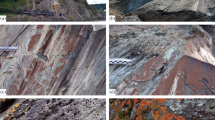Abstract
The Sierra de Cazorla, Jaen, Spain, is characterizedby the presence of a number of shelters or smallcavities with important late prehistoric paintings,the so-called schematic rock art painting. Themicrobial population of the rocks supporting paintingsfrom two shelters was investigated. Bacteria isolatedfrom Cueva del Encajero triplicated the number ofthose isolated from Cueva de la Graja, as correspondedto a higher environmental humidity. However, thebacteria isolated from Cueva de la Graja weremetabolically more active and able to use a highernumber of carbon sources than those of Cueva delEncajero. As demonstrated by cluster analysis themicrobial communities from both shelters are related,in spite of the different ecological conditions andgeographical distribution.
Similar content being viewed by others
References
Berkeley R.C.W.: 1971, Microbiology of soil. In: L.E. Hawker and A.H. Linton (eds), Micro-organisms: Function, Form and Environment. Edward Arnold, London, pp. 479-514.
Bromfield S.M.: 1954, Reduction of ferric compounds by soil bacteria. J. Gen. Microbiol. 11, 1-6.
Gonzalez I., Laiz L., Hermosin B., Caballero, B. Incerti C. and Saiz-Jimenez C.: 1999, Bacteria isolated from rock art paintings: the case of Atlanterra shelter (South Spain). J. Microbiol Meth. 36, 123-127.
Groth I. and Saiz-Jimenez C.: 1999, Actinomycetes in hypogean environments. Geomicrobiol. J. 16, 1-8.
Groth I., Vettermann R., Schuetze B., Schumann P. and Saiz-Jimenez C.: 1999, Actinomycetes in karstic caves of Northern 124 Spain (Altamira and Tito Bustillo). J. Microbiol. Meth 36, 115-122.
Hoyos M.: 1993, Procesos de alteracion de soporte y pintura en diferentes cuevas con arte rupestre del Norte de España: Santimamiñe, Arenaza, Altamira y Llonin. In: F.J. Fortea (ed), La Proteccion y Conservacion del Arte Rupestre Paleolitico. Servicio de Publicaciones del Principado de Asturias, Oviedo, pp. 51-74.
Kölbel-Boelke J., Anders E. and Nehrkorn A.: 1988, Microbial communities in the saturated groundwater environment. II. Diversity of bacterial communities in a Pleistocene sand aquifer and their in vitro activities. Microb. Ecol. 16, 31-48.
Laiz L., Groth I., Gonzalez I. and Saiz-Jimenez C.: 1999, Microbiological study of the dripping waters in Altamira cave (Santillana del Mar, Spain). J. Microbiol. Meth. 36, 129-138.
Sasser M.: 1990, Identification of Bacteria by Gas Chromatography of Cellular Fatty Acids. MIDI Technical Note 101. Newark, DE.
Scott D.A. and HyderW.D.: 1993, A study of some Californian rock art pigments. Stud. Conserv. 38, 155-173.
Author information
Authors and Affiliations
Corresponding author
Rights and permissions
About this article
Cite this article
Laiz, L., Hermosin, B., Caballero, B. et al. Bacteria isolated from the rocks supporting prehistoricpaintings in two shelters from Sierra de Cazorla, Jaen, Spain. Aerobiologia 16, 119–124 (2000). https://doi.org/10.1023/A:1007684904350
Issue Date:
DOI: https://doi.org/10.1023/A:1007684904350




